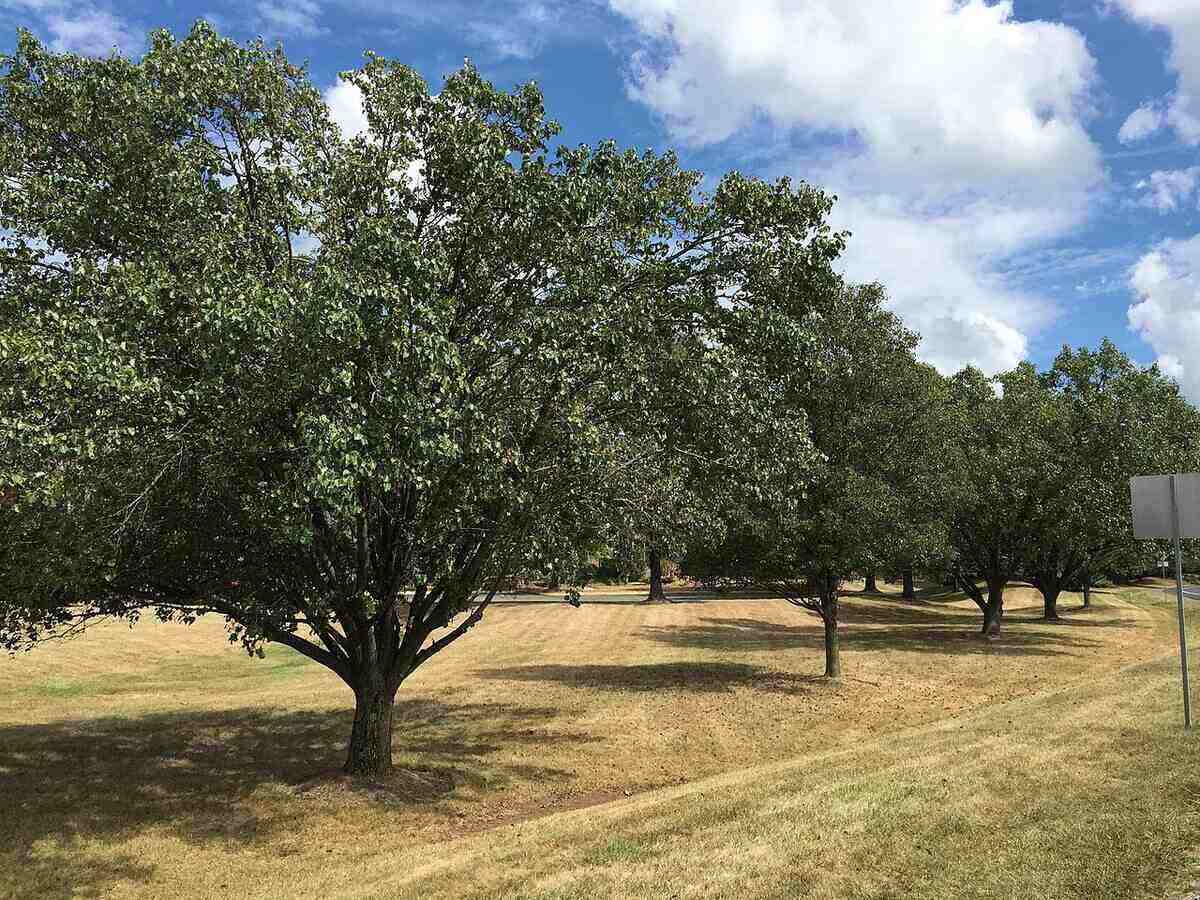
Trees struggling with drought need immediate action — here’s your emergency rescue plan (with expert tips) for how to take care of trees during a drought.
Follow these steps: Water 12 to 18 inches deep, mulch 2 to 4 inches thick, prune minimally, and avoid fertilizers. Use a soaker hose to apply water slowly on the outer half of the canopy and let the soil dry between irrigations. Keep this up until it rains — it’s your tree’s lifeline through extended drought conditions.
Keith O’Herrin, urban forester at North Carolina Cooperative Extension, says homeowners’ biggest mistake during a drought is giving up too soon on their trees.
“In Texas, I saw two 200-plus-year-old bald cypress [trees] brown out and drop their leaves during an extreme drought. Many people immediately jumped to remove those trees, assuming the drought had killed them. But the trees weren’t removed and leafed out well the next spring.”
Watering your trees is more effective than you might think.
The Right Watering Techniques
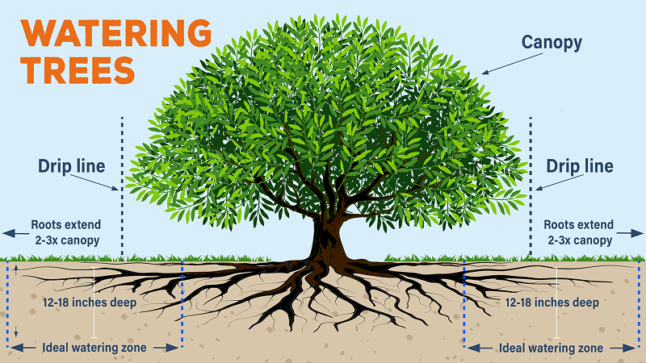
We all love low-maintenance trees, but drought can change your tree’s needs. Water is the most important factor for tree survival and growth, so don’t ignore the signs of drought stress in trees. As soon as you notice leaves wilting or scorched leaf edges, start watering your trees.
Note: If the signs show severe drought damage, like peeled-off bark or fungal infections, call a tree care expert.
Here’s how to water your trees during a drought:
- Focus on the critical root zone: Water young and newly planted trees directly over the root ball (the planting area). For mature trees, water the soil beneath the canopy focusing on the outer half of the canopy and the drip line, where most of the feeder roots grow.
- Deep, infrequent watering: Water young and newly planted trees 1-3 times a week and mature trees every 1-2 weeks. Ensure 1-2 inches of water per week and aim to moisten (not saturate) the soil 12 to 18 inches deep.
- Water in the evening or early morning: According to professor Kim Coder at the University of Georgia, the best time to water trees is between 10 p.m. to 6 a.m. when trees refill their water reserves.
- Use a soaker hose or a drip irrigation system: Apply the water on the soil, not on the trunk or foliage to limit fungal diseases.
- Apply water slowly. Utah State University recommends using emitters with a flow rate of 1 to 8 gallons per hour.
- Avoid overwatering: Allow the soil to dry between irrigations.
Random rain showers feel like heaven during heat and drought, but can be misleading. Did it rain enough to skip an irrigation? You can’t really know unless you test the soil moisture.
Push a screwdriver or moisture meter into the ground below the tree’s canopy — the distance it penetrates without resistance shows how deep the moisture has soaked in. If it’s at least 6 inches, you can postpone watering a few days.
See Related: How Much Does Drip Irrigation Cost?
Follow Local Watering Restrictions
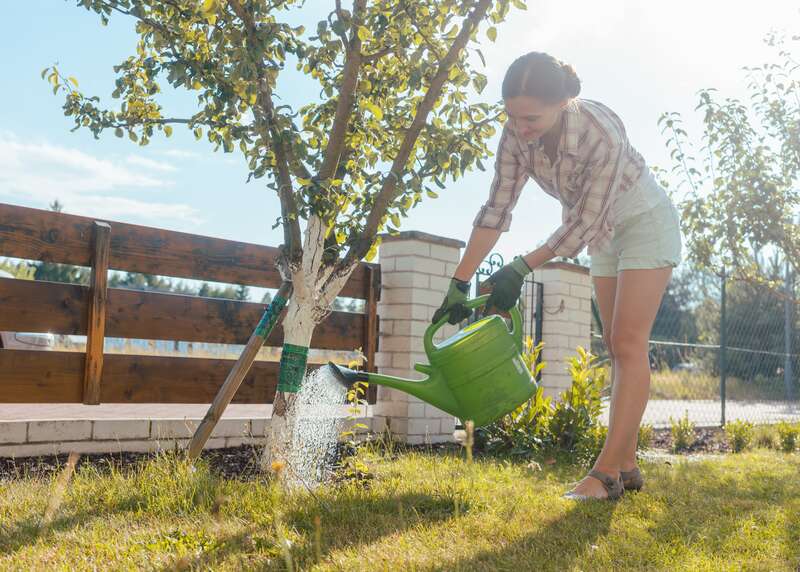
If there’s a watering ban, check with the local authorities to see whether tree irrigation is still allowed. Drip irrigation systems and soaker hoses are usually permitted even during watering restrictions.
Note: In areas with frequent water restrictions, you can prevent drought damage by considering drought-tolerant landscaping ideas with water-wise grasses and drought-resistant trees.
See Related:
- What is Drought-Tolerant Landscaping?
- Best Drought-Tolerant Shrubs
- Best Drought-Tolerant Ground Covers
Proper Mulching
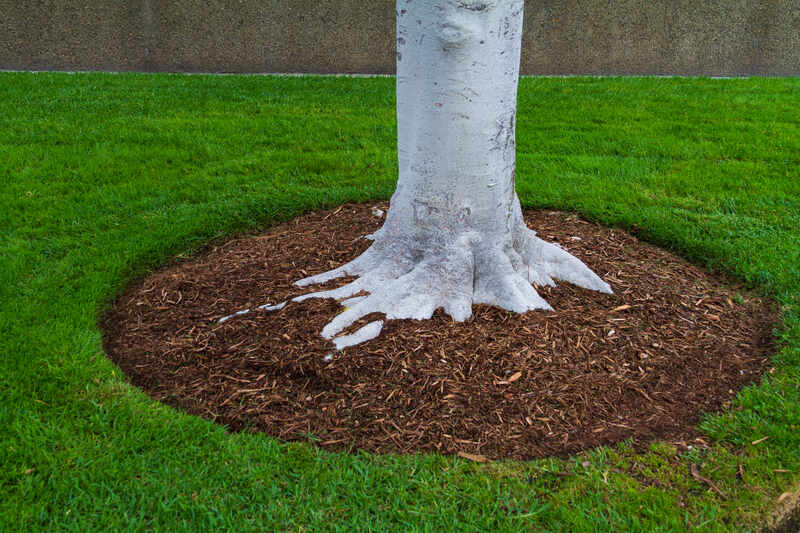
Mulch can save your tree’s life during a drought by conserving water. In fact, studies show that covering the soil with a 2-inch-thick mulch reduces water evaporation by up to 40%, leading to more drought-tolerant trees and a lower water bill.
Plus, mulch protects shallow roots from overheating, limits weed growth, and, according to O’Harrin, is better than planting turfgrass, “a fierce competitor for nutrients and moisture in the soil.”
Here’s how to mulch correctly around your trees:
- Choose organic mulch such as tree bark, wood chips, and straw. Don’t use gravel or stones; this type of mulch heats up when exposed to direct sunlight.
- Apply a layer 2 to 4 inches thick. It limits evaporation without blocking rain.
- Keep mulch off the tree trunk: Spread the mulch across the root zone, but keep it 3-6 inches away from the trunk to prevent fungal infections and decay.
- Reapply and fluff up: Reapply mulch when the layer thins out. Fluff it up with a rake from time to time to prevent it from matting down and repelling water.
Pro Tip: O’Harrin says to water the mulch after spreading it since it’s often dry. Otherwise, “the first few rainfalls will be absorbed by the mulch, robbing the tree of that moisture and unintentionally manufacturing a drought experience for your tree,” he says.
See Related:
- Mulch Calculator: How Much Mulch Do You Need?
- How to Choose the Right Mulch Color for Your Landscape
Smart Pruning
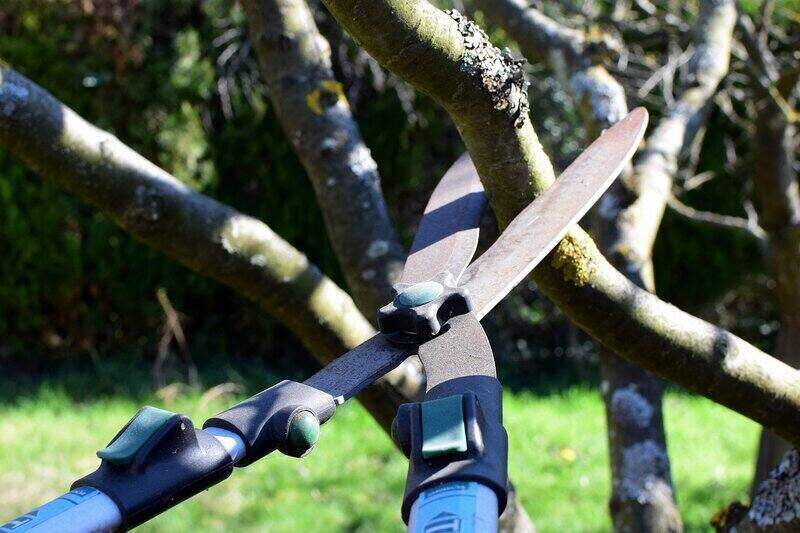
Pruning trees removes part of their food reserves, weakens their immune system, and increases the risk of diseases and pests. If your trees are already stressed by drought, only prune IF absolutely necessary, and take extra precautions while cutting:
- Only remove dead, diseased, or pest-infested branches.
- Sterilize tools between cuts to prevent spreading diseases.
- Make proper cuts or call a tree care professional to prune the tree if you don’t have experience.
- Don’t use pruning paints or wound dressings. They slow down the healing process.
| If any of your tree branches are dead, diseased, or infested with insects, hire a LawnStarter tree care pro to prune them. Our pros charge an average of $238 per job for light tree pruning. |
See Related:
No Fertilizers
Fertilizers can do more harm than good during a drought. They trigger growth, demanding more water and energy from an already deficient tree and also add salts into dry soil, exposing the tree to root burn.
Tree care professionals use special techniques during drought. According to O’Harrin, if nutrients are needed, ISA certified arborists do a “deep-root fertilization (pressurized water injected into the soil with fertilizer).”
They might also use “insecticide injections to prevent attack from wood-boring beetles.”
Soil Management
Compacted soil heats up faster, preventing water, oxygen, and nutrients from reaching the tree roots. It can make a drought spell worse for your trees, so try these techniques to improve its quality:
- Test for soil compaction. Push a screwdriver into moist soil. If you need to force it or it gets stuck a few inches into the soil, the ground is compacted.
- Aerate if needed. Call a tree care professional to aerate the soil with an air spade. This tool uses compressed air to break down the soil and doesn’t harm the tree roots. If you want to DIY with a core aerator or a garden fork, aerate only beyond the dripline.
- Add compost to help with water retention. Spread a 2-inch layer of compost on the soil surface. It’s rich in organic matter which absorbs and holds water like a sponge for tree roots to use.
When to Call a Professional vs. DIY Treatment
- DIY interventions are effective while the tree is in the early stages of drought damage (wilted leaves, browning at the leaves tips and edges, some fallen leaves).
- Call a certified arborist when: You notice severe damage such as dead branches, bark peeling off, pest infestations, or more than 50% leaf loss.
An arborist consultation typically costs $75 to $250 per hour. Tree removal costs between $385 to $1,070 and planting a new tree is $150 to $1,850, making a consultation a good first step.
FAQ
Trees suffering from drought show specific signs, such as:
• Wilted foliage and changes in leaf color (yellow, brown, or scorched)
• Thinned canopy and fallen leaves
• Cracks in the bark and dry branches
• An increase in pests and disease presence
• Smaller leaves and stunted growth
Young trees are more vulnerable to drought stress and should have priority during severe water restrictions.
Gray water can be used to water trees during drought with minimal processing. However, some states still restrict the use of gray water for yard irrigation, so check your local regulations to see what applies for your community.
Resilient Trees with Professional Care
Give your trees the best chance to survive prolonged drought. Find an experienced tree care expert with LawnStarter and enjoy your trees’ comforting shade for decades to come.
Sources:
- Keith O’Herrin, urban forester at North Carolina Cooperative Extension, Union County center, Monroe, NC. Personal interview.
- “Pruning Drought Stressed Shade Trees.” By Kelly Feehan, Lincoln Extension Educator. University of Nebraska.
- “Routes to Roots: Direct Evidence of Water Transport by Arbuscular Mycorrhizal Fungi to Host Plants.” By biochemistry specialists Anne Kakouridis, John A. Hagen, Megan P. Kan, Stefania Mambelli, Lewis J. Feldman, Donald J. Herman, Peter K. Weber, Jennifer Pett-Ridge, Mary K. Firestone. University of California Berkeley.
- “Tree Care During a Drought.” University of Florida Extension.
- “Tree Wounds and Healing.” By Lindsey Purcell, chapter executive director at Indiana Arborist Association. Purdue University Extension.
- “The Effect of Mulch Type and Thickness on the Soil Surface Evaporation Rate.” By Michael Scott Mcmillen, Iowa State University.
- “Watering Trees.” By Kim D. Coder, professor of Tree Biology & Health Care. University of Georgia Warnell School of Forestry & Natural Resources.
- “Watering Trees.” By Wayne K. Clatterbuck, associate professor in the department of Forestry, Wildlife & Fisheries, and Larry Tankersley, extension forester in the department of Forestry, Wildlife & Fisheries. University of Tennessee Extension.
Main Photo Credit: Callery Pear tree on a dry, brown lawn during drought. Famartin / Wikimedia Commons / CC BY-SA 4.0